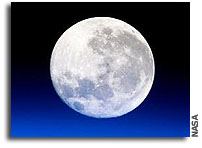ISRO to be part of NASA's second generation International Lunar Network initiative
31 Jul 2008
Moffett Field, USA: NASA said it hosted a meeting of space agencies from nine countries last week to discuss the next steps in the ongoing scientific exploration of the moon. According to the space agency, the meeting laid the groundwork for a new generation of work related to lunar science.
 Representatives from space agencies in Canada, France, Germany, India, Italy, Japan, the Republic of Korea, the United Kingdom, and the United States attended the meeting. The focal point of the discussions was cooperation on an international activity called the International Lunar Network (ILN).
Representatives from space agencies in Canada, France, Germany, India, Italy, Japan, the Republic of Korea, the United Kingdom, and the United States attended the meeting. The focal point of the discussions was cooperation on an international activity called the International Lunar Network (ILN).
The network is designed to gradually place 6-8 fixed or mobile science stations on the lunar surface. These stations will form a second-generation robotic science network to replace hardware left by the Apollo programme to study the moon's surface and interior.
NASA plans to place its first two ILN landers on the surface of the moon in 2013-14. The landers are being developed under the Lunar Precursor Robotic Program at NASA's Marshall Space Flight Center. Huntsville, Ala.
Representatives from space agencies considering participation in the ILN agreed on a statement of intent as a first step in planning. The statement marked an expression of interest by the agencies to study options for participating in a series of international lunar missions.
The goal is to form a network of missions that will benefit scientists worldwide.
The statement of intent does not completely define the ILN concept. The document leaves open the possibility for near and long-term evolution and implementation. Initially, participants intend to establish potential landing sites, interoperable spectrum and communications standards, and a set of scientifically equivalent core instrumentation to carry out specific measurements.
Discussions were held at NASA's Lunar Science Institute, located at the Ames Research Center at Moffett Field, Calif.
"We are tremendously excited by the enthusiasm shown for the ILN and lunar science more broadly," said Jim Green, director of the Planetary Science Division at NASA Headquarters. "This international activity will greatly extend scientific knowledge of the moon in a number of important areas."
"We are in a new era of lunar exploration," said Jim Adams, deputy director of the Planetary Science Division at NASA Headquarters. "Scientific coordination of the international armada of missions being sent to the moon in the next decade will greatly leverage our scientific capabilities, and perhaps even more importantly, develop the next generation of lunar scientists."
International participation in specific ILN activities will be established by appropriate international agreements. Additional participants may join in the future when they are programmatically and financially ready.
Participation in the ILN could include the contribution of landers, orbiters, instrumentation, or other significant infrastructure, such as ground segment elements or power supplies for surviving the lunar night.






























